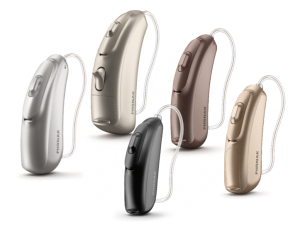 Intelligent hearing aids that learn
Intelligent hearing aids that learn
Imagine having a hearing professional by your side constantly adjusting your hearing aid settings to best match your hearing needs in different situations. This is what hearing aid learning technology is all about except you can leave the clinician back in the clinic
Hearing aid learning is a relatively new technology available in some hearing aids. This technology allows hearing aid wearers to “teach” the hearing aids their volume preferences for sounds in their everyday environment.
Every individual has different needs, preferences, lifestyles and of course hearing loss. The clinician has a challenging role in fitting hearing aids, ensuring that the hearing aids are optimally programmed to satisfy these unique hearing needs and preferences. The clinician may begin with case history to understand lifestyle needs and preferences, measure and quantify the hearing loss, then attempt to program the hearing aids accordingly. A follow up appointment is usually scheduled some weeks after the fitting once the wearer has experienced the hearing aids in their everyday environments. Based on the wearer’s feedback, if the hearing aids were too loud or too soft in certain situations, the clinician would fine tune the hearing aids to optimise the hearing aid performance for the wearer.
There are some challenges in this process. Firstly, the clinician not having the first hand experience in the wearer’s hearing situations, may not be able to comprehend the factors contributing to their hearing difficulties. Neither is it easy for wearers to accurately communicate their sound preferences for a host of hearing situations. Finally, the hearing clinics are usually soundproofed for the purpose of conducting hearing tests, bearing little resemblance to real world listening situations. A hearing aid that is optimally fitted in a quiet soundproof room may not always perform adequately in real life noise-filled environments.
“Learning” technology attempts to ameliorate the hearing aid fitting process by closing the gap between the initial first fit by the audiologist and the ultimate hearing needs of the wearer.
What is hearing aid learning?
Hearing aids aim to optimise speech understanding for the wearer. To do so, the hearing aids’ loudness must be adjustable across a range of frequencies (low to high) to match the hearing profile of the individual’s hearing loss. At the same time, hearing aids need to be adjustable for different sound levels: soft, moderate and loud sounds. Soft sounds should be audible; moderate sounds comfortable and loud sounds bearable.
Most hearing aids have multiple programs to cater to different listening situations. Each listening program can be set differently to provide an optimal hearing experience. For example, a noise program may provide a directional microphone, more aggressive noise cancellation and a softer volume level to provide for listening comfort. Many digital hearing aids can automatically switch between hearing programs depending on the acoustic situation the user is in.
“Learning” technology enables wearers to “teach” the hearing aids their volume preferences in their personal listening environments. The initial settings provided by the clinician, after careful testing and consultation, forms the basis for the hearing aid to optimally learn the wearer’s hearing needs and preferences in the real-world.
The hearing aids learn the user’s volume preferences as the wearer makes changes to the volume control in their day-to-day activities. Presently there are various levels of “learning” across hearing aids. At the basic level, hearing aids can learn an wearer’s overall preferred volume through the adjustments made to the volume control. As the wearer adjusts the volume control on the hearing aid on a day to day basis, the hearing aid over time averages out the changes made. The hearing aid increases or decreases the volume level accordingly. After some weeks, the hearing aid gets closer to the preferred volume level of the wearer.
More sophisticated hearing aids are able to learn the wearer’s preferred loudness differently across the frequency range (ie the timbre and base preference) and loudness preferences for soft, moderate and loud sounds in different acoustic situations (such as quiet, speech in quiet, noise, speech in noise, car and music).
This is again done automatically through the adjustments made to the physical volume control of the hearing aid. Each time the wearer makes an adjustment to the volume control, the hearing instrument remembers the volume in that particular environment at that exact point in time and stores the sound setting (level of soft, medium or loud sound) and the situation (e.g. car, music) when the change was made. The device then keeps a tally of these changes and adjusts the sound levels accordingly.
‘Learning” technology is an asset to both hearing aid wearers and clinicans. The technology offer hearing aid wearer’s a sense of control as they are not just a passive observer but active in the fine tuning process. The technology can reduce the number of follow-up appointments needed which is especially beneficial for individuals living in remote locations with limited access to hearing clinics, and to those in poor health who find it difficult to attend appointments.





